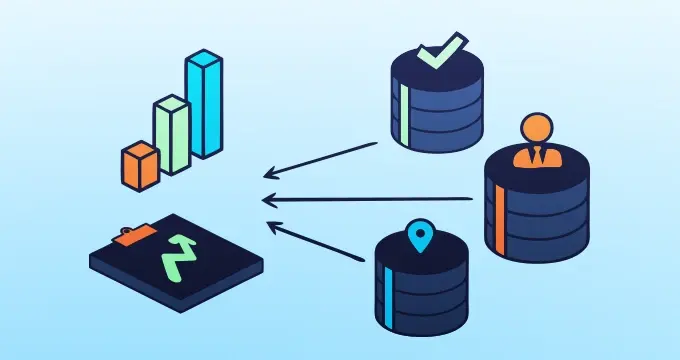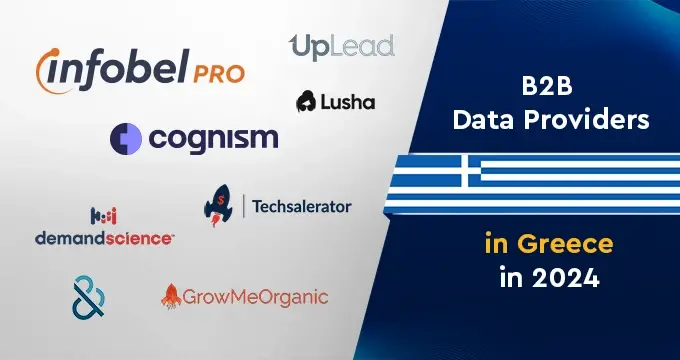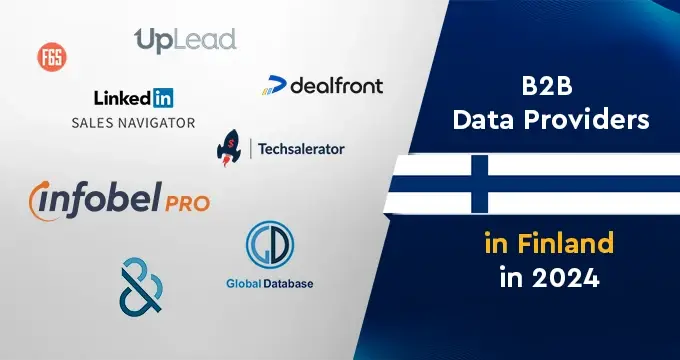Technographic information offers a wealth of knowledge that sheds light on a company's technology utilization.
It encompasses the products and systems the company relies on, making it an invaluable resource for businesses aiming to make informed decisions.
This type of data supports a range of activities, from competitive intelligence and customer segmentation to product development and sales and marketing.
What is Technographic Data?
Technographic information blends technology usage data with firmographic data to form a comprehensive profile of a company's technology landscape and usage patterns.
It encompasses information about a company's technological characteristics, such as the hardware, software, and tools utilized, as well as the sophistication of their technology ecosystem.
By driving into technographic information, sales and marketing teams can gain a deeper understanding of their target customers, including their technology priorities and the tools they utilize to run their business operations.
Types of Technographic Data
There are several types of technographic data, including:
Software Technographics
Software technographics refer to information about the software products and systems that a company uses.
This type of data can include information about the types of software a company uses, such as customer relationship management (CRM) software, enterprise resource planning (ERP) software, or project management tools.
It can also provide details about the specific products and vendors used, including information about their license agreements and usage patterns.
By understanding a company's software stack, sales and marketing teams can gain insights into their technology priorities and the specific challenges they face.
This information can be used to tailor product and service offerings to the needs of the target customer and provide more targeted solutions.
Hardware Technographics

Hardware technographics refers to information about the physical devices and hardware products used by a company.
This data can encompass the types of devices utilized, like desktops, laptops or mobile devices, as well as the specifics of the hardware products, such as the make, model and specifications.
This information can offer an understanding of a company's technology setup and assist sales and marketing teams to comprehend the hardware their potential customers use.
This data can then be employed to personalize product and service offerings to better match the target customer's hardware setup.
Website Technographics
Website technographics refers to information about a company's web technology, including their website and digital presence.
This type of data can include information about the content management system (CMS) used to manage the website, website analytics tools, optimization tools, and e-commerce platforms.
Some common data points in website technographics include the website's platform. Such as WordPress, Shopify, or custom-built, hosting provider, analytics tools, marketing automation tools and various plugins or widgets that are in use.
By examining a company's digital presence, Website Technographics provides insight into their online strategy and enables marketing and sales reps to better understand the digital channels and tools utilized by their target customers.
This information can be used to tailor digital marketing efforts and ensure that the right message is delivered through the most effective channels.
By having a deep understanding of the web technology used by a target customer, marketing and sales teams can offer more focused solutions and improve the overall results of their digital marketing efforts.
Why Does Technographic Data Matter?
Technographic data is becoming increasingly important for marketing and sales teams who want to reach their target accounts with the most relevant products and services.
By providing insights into a company's technology stack, technographic data can help teams to make informed decisions about the products and services they offer and the most effective ways to reach potential customers.
For example, if a company uses a certain type of software or tool, a sales team can use this information to tailor their pitch to the specific needs of that company.
Additionally, by understanding a company's technology stack, sales teams can identify opportunities to upsell and cross-sell additional products and services.
Utilizing Technographic Data in Business Decisions
Technographic data can play a role in a variety of business decisions and activities. Here are some ways that businesses can use technographic data to make informed decisions:
Competitive Intelligence
Technographic data can provide valuable insights into your competitors' technology usage and preferences, allowing you to stay one step ahead.
By understanding which technologies your competitors are using, you can identify potential weaknesses and opportunities. You can then modify your own product development strategies, and make data-driven decisions that give you a competitive edge.
Technographic data can also help you understand the technology trends and preferences within your industry. It allows you to stay ahead of the curve and make informed decisions.
Sales and Marketing

Technographic data can inform sales and marketing strategies by providing a deeper understanding of your target audience's technology preferences and usage.
By knowing which technologies and platforms your target audience is using, you can tailor your messaging and communication strategies to more effectively engage with them.
Additionally, technographic data can inform the development of personalized and relevant marketing campaigns, increasing the likelihood of success and driving higher conversion rates.
Lead Generation
One of the key benefits of using technographic data is the ability to identify and target specific customer segments more effectively.
For example, if you're targeting e-commerce companies, you can use technographic data to find out which websites are using technologies like Shopify, WooCommerce, or payment methods like Stripe or PayPal.
This information can then be used to more easily identify and target leads in your desired customer segment. With technographic data, businesses can gain a deeper understanding of their target market, helping to inform and refine their marketing and sales strategies.
Product Development
Technographic data can inform product development and improvement by providing insights into customer preferences and technology usage patterns.
By understanding which technologies are most popular and in demand among your target audience, you can tailor your product offerings and features to better meet their needs and preferences.
Technographic data can also inform the development of new products and services, helping to ensure that you are providing what your customers want and need.
Additionally, by monitoring your competitors' technology usage, you can identify new trends and opportunities to differentiate your products and stay ahead of the competition.
Methods and Tools for Collecting Technographic Data
There are several methods and tools that businesses can use to collect technographic data. Here are some common methods and tools:
Scraping
Scraping is a technique used to gather information from various digital sources, including websites, using specialized software.
Pros:
- Plenty of information: By using specialized software, scraping can access plenty of information about technology products and platforms.
- Time-saving: Because it is an automated process, scraping is significantly faster to collect data.
Cons:
- Specialized skills and resources required: Expertise in web scraping techniques and access to efficient scraping tools are necessary for successful scraping.
- Data accuracy at risk: The collected data may be inaccurate and inconsistent, particularly when working with complex websites and vast amounts of data.
- Ethical and legal implications: It is important to consider the ethical and legal considerations of scraping, as some websites may have restrictions on the use of their data.
Data Aggregators
Data Aggregators are organizations that collect and market data to various businesses.
Pros:
- Comprehensive information: Data aggregators offer comprehensive information about technology products and platforms.
- Accurate data: A combination of web scraping, machine learning, and human research are used to collect accurate and complete data.
Cons:
- Cost considerations: The cost of purchasing data from these companies should be taken into account.
- Data reliability evaluation: The reliability of the data provided by these companies should be evaluated, as some are just using scraping.
Web Extensions
Web extensions are additional tools that can be added to a web browser to enhance its functionality and provide information about websites.
Pros:
- Comprehensive insights: Offers in-depth information about a company's web technology.
- User-friendly: Easy to use and accessible through a web browser.
Cons:
- Time-consuming for large scale analysis: The process of collecting technographic data through web extensions can be time-consuming when evaluating multiple websites, as it requires a site-by-site analysis.
Surveys and Interviews

Conducting surveys, interviews, and market research with customers, partners, and other relevant parties can offer valuable insights into the technology products and platforms used by a company. This approach provides the opportunity to gather information directly from the source and ask targeted questions to gain a deeper understanding of the technology landscape.
Pros:
- Offers direct access to information from the source: Conducting surveys, interviews and market research provides an opportunity to gather information directly from customers, partners, and other stakeholders.
- Allows for a deeper understanding: Asking specific questions during surveys and interviews can provide a deeper understanding of a company's technology landscape.
Cons:
- Time-consuming: This method can take longer compared to other methods of collecting technographic data.
- Limited scope: May not provide a complete view of all the technology products and platforms used by a company, as well as information about potential prospects or competitors.
Public Data Sources
Public data sources, including company websites, press releases, and regulatory documents, can offer information about a company's technology products and platforms.
Pros:
- Accessible and cost-effective: The information can be obtained for free through publicly available sources.
Cons:
- Incomplete picture: The data obtained may not provide a comprehensive view of a company's technology landscape as companies may not publicly disclose all of their technology products and platforms.
- Inefficient for large volumes: This method may not be the most optimized solution for collecting large amounts of data, as it is likely to be the most time-consuming.
Best Practices for Collecting and Analyzing Technographic Data
Collecting and analyzing technographic data is a crucial aspect of using this information to inform business decisions. Here are some best practices for effectively collecting and analyzing technographic data:
- Start with a clear goal: Before collecting technographic data, it is important to have a clear understanding of what you hope to accomplish. This will help ensure that the data you collect is relevant and valuable.
- Use multiple sources: To get a comprehensive view of a company's technology usage, it is important to use multiple sources of data.
- Use the right tools: There are a variety of tools available for collecting and analyzing technographic data. It is important to choose the right tools for your needs and to use them effectively.
- Clean and validate the data: It is important to clean and validate the data you collect to ensure that it is accurate and reliable. This may involve removing duplicates, correcting errors, and verifying the data against other sources.
- Use the data to inform specific decisions: Once you have collected and analyzed technographic data, it is important to use this information to inform specific business decisions. For example, use the data to inform sales and marketing efforts, product development, or competitive intelligence strategies.





Comments